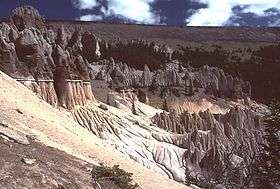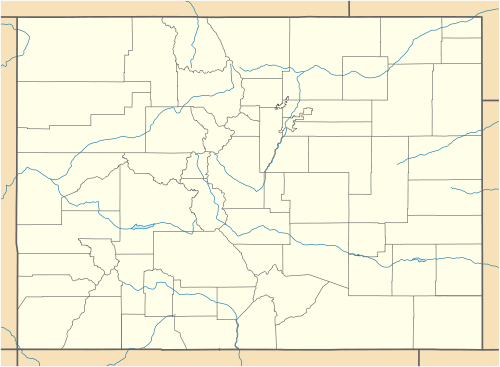La Garita Caldera
| La Garita Caldera | |
|---|---|
 Volcanic ash formations of La Garita Caldera, looking northeast (Wheeler Geologic Monument). | |
| Highest point | |
| Coordinates | 37°45′23″N 106°56′03″W / 37.75639°N 106.93417°WCoordinates: 37°45′23″N 106°56′03″W / 37.75639°N 106.93417°W |
| Geography | |
 La Garita Caldera Location of La Garita Caldera within Colorado | |
| Location | Mineral County, Colorado, US, near Creede |
| Parent range | San Juan Mountains |
| Geology | |
| Mountain type | Caldera |
| Last eruption | 26.3 Ma (Fish Canyon Tuff 27.8 Ma) |
La Garita Caldera is a large volcanic caldera located in the San Juan volcanic field in the San Juan Mountains near the town of Creede in southwestern Colorado, United States.[1] It is west of La Garita, Colorado. The eruption that created the La Garita Caldera is among the largest known volcanic eruptions in Earth's history.[2][3]
Date
The La Garita Caldera is one of a number of calderas that formed during a massive ignimbrite flare-up in Colorado, Utah and Nevada from 40–18 million years ago, and was the site of massive eruptions about 28.01± 0.04 million years ago, during the Oligocene Epoch.[4]
Area devastated
The area devastated by the La Garita eruption is thought to have covered a significant portion of what is now Colorado. The deposit, known as the Fish Canyon Tuff, covered at least 30,000 km2 (11,000 miles2). Its average thickness is 100 m. The eruption might have formed a large-area ash-fall, but none has yet been identified.[5]
Size of eruption
The scale of La Garita volcanism was the second greatest of the Cenozoic Era. The resulting Fish Canyon Tuff has a volume of approximately 1,200 cubic miles (5,000 km3), rating it an 8 on the Volcanic Explosivity Index. This is enough material to fill Lake Michigan. By comparison, the May 18, 1980, eruption of Mt. St. Helens was 0.25 cubic miles (1.0 km3) in volume.[6]
By contrast, the most powerful human-made explosive device ever detonated, the Tsar Bomba, had a yield of 50 megatons, whereas the eruption at La Garita was about 5,000 times more energetic. However, because Tsar Bomba's reaction was complete within microseconds, while a volcanic explosion can take seconds or minutes, the power of the events are comparable if measured within the respective bounded timeframes. It is the most energetic event to have taken place on Earth since the Chicxulub impact which, at 240,000 gigatons,[7] was approximately one thousand times more powerful than La Garita.
Geology
The Fish Canyon Tuff, made of dacite, is uniform in its petrological composition and forms a single cooling unit despite the huge volume. Dacite is a silicic volcanic rock common in explosive eruptions, lava domes and short thick lava flows. There are also large intracaldera lavas composed of andesite, a volcanic rock compositionally intermediate between basalt (poor in silica content) and dacite (higher silica content) in the La Garita Caldera.
The caldera itself, like the eruption of Fish Canyon Tuff, is quite large in scale. It is 35 by 75 kilometers (22 by 47 mi) and oblong in shape. Most supervolcano calderas of explosive origin are slightly ovoid or oblong in shape. Because of the vast scale and erosion, it took scientists over 30 years to fully determine the size of the caldera. La Garita is considered an extinct.
La Garita is also the source of at least 7 major eruptions of welded tuff deposits over a span of 1.5 million years since the Fish Canyon Tuff eruption. The caldera is also known to have extensive outcrops of a very unusual lava-like rock unit, called the Pagosa Peak Dacite, made of dacite that is very similar to that of the Fish Canyon Tuff. The Pagosa Peak Dacite, which has characteristics of both lava and welded tuff, was erupted probably shortly before the Fish Canyon Tuff. The Pagosa Peak Dacite has been interpreted as having erupted as thick spatter during low-energy lava fountaining and has a volume of about 200–300 cubic kilometers (48–72 cu mi). These rocks had been identified as lava because the unit has a high aspect ratio (1:50) and very high viscosity of the crystal-rich magma similar to those of flow-layered silicic lava. However, the Pagosa Peak Dacite formed by low-column pyroclastic fountaining and lateral transport as dense, poorly-inflated pyroclastic flows.[8]
See also
References
- ↑ Steven, Thomas A.; Lipman, Peter W. (1976). "Calderas of the San Juan Volcanic Field, Southwestern Colorado". U.S. Geological Survey Professional Papers. Washington, DC: U.S. Government Printing Office. 958: 1–35. Retrieved 2012-05-16.
- ↑ "What's the Biggest Volcanic Eruption Ever?". livescience.com. November 10, 2010. Retrieved 2014-02-01.
- ↑ Best, MG (2013). "The 36–18 Ma Indian Peak–Caliente ignimbrite field and calderas, southeastern Great Basin, USA: Multicyclic super-eruptions". Geosphere. doi:10.1130/GES00902.1.
- ↑ Phillips, D (2013). "Ultra-high precision 40Ar/39Ar ages for Fish Canyon Tuff and Alder Creek Rhyolite sanidine: New dating standards required?". Geochimica et Cosmochimica Acta. doi:10.1016/j.gca.2013.07.003.
- ↑ Lipman3, PW (2000). "Central San Juan caldera cluster: regional volcanic framework". Geological Society of America Special Papers. doi:10.1130/0-8137-2346-9.9.
- ↑ Mason, et al.
- ↑ Hildebrand; et al. (1998). "Mapping Chicxulub crater structure with gravity and seismic reflection data". The Geological Society.
- ↑ Bachmann, O.; Dungan, M.A.; Lipman, P.W. (May 2000). "Voluminous lava-like precursor to a major ash-flow tuff: low-column pyroclastic eruption of the Pagosa Peak Dacite, San Juan volcanic field, Colorado". Journal of Volcanology and Geothermal Research. 98 (1–4): 153–171. doi:10.1016/S0377-0273(99)00185-7. Retrieved 24 September 2015.
Bibliography
- Lipman, Peter W.; Robinson, Joel E.; Dutton, Dillon R.; Ramsey, David W.; Felger, Tracey J. (2006). Geologic Map of the Central San Juan Caldera Cluster, Southwestern Colorado. USGS Geologic Investigations Series I-2799. (includes maps, photo collection, and links to on-line abstracts)
- Mason, Ben G.; Pyle, David M.; Oppenheimer, Clive (2004). "The size and frequency of the largest explosive eruptions on Earth". Bulletin of Volcanology. 66 (8): 735–748. Bibcode:2004BVol...66..735M. doi:10.1007/s00445-004-0355-9.
- Askren, Daniel R.; Rodden, Michael F.; Whitney, James A. (1997). "Petrogenesis of Tertiary Andesite Lava Flows Interlayered with Large-Volume FelsicAsh-Flow Tuffs of the Western USA" (PDF). Journal of Petrology. 38 (8): 1021–1046. doi:10.1093/petrology/38.8.1021. Archived from the original (PDF) on May 28, 2008. Retrieved 2007-05-02.
- Largest explosive eruptions: New results for the 27.8 Ma Fish Canyon Tuff and the La Garita caldera, San Juan volcanic field, Colorado
- The Mid-Tertiary Ignimbrite Flare-Up
External links
- USGS Hawaiian Volcano Observatory: Supersized eruptions are all the rage!
- Maps:
- Robinson, Joel E.; Dutton, Dillon R.; Ramsey, David W.; Lipman, Peter W.; Felger, Tracey J. (2006). Geologic Map of the Central San Juan Caldera Cluster, Southwestern Colorado: Geologic Investigations Series. I-2799. U.S. Geological Survey. Retrieved 2010-05-03.
- "Central Colorado Volcanic field". Journal of Petrology. Retrieved 2010-03-16.
- "Central Colorado Volcanic field". Dr. Matthew E. Brueseke, Department of Geology, Kansas State University. Archived from the original on 2011-07-19. Retrieved 2010-03-26.